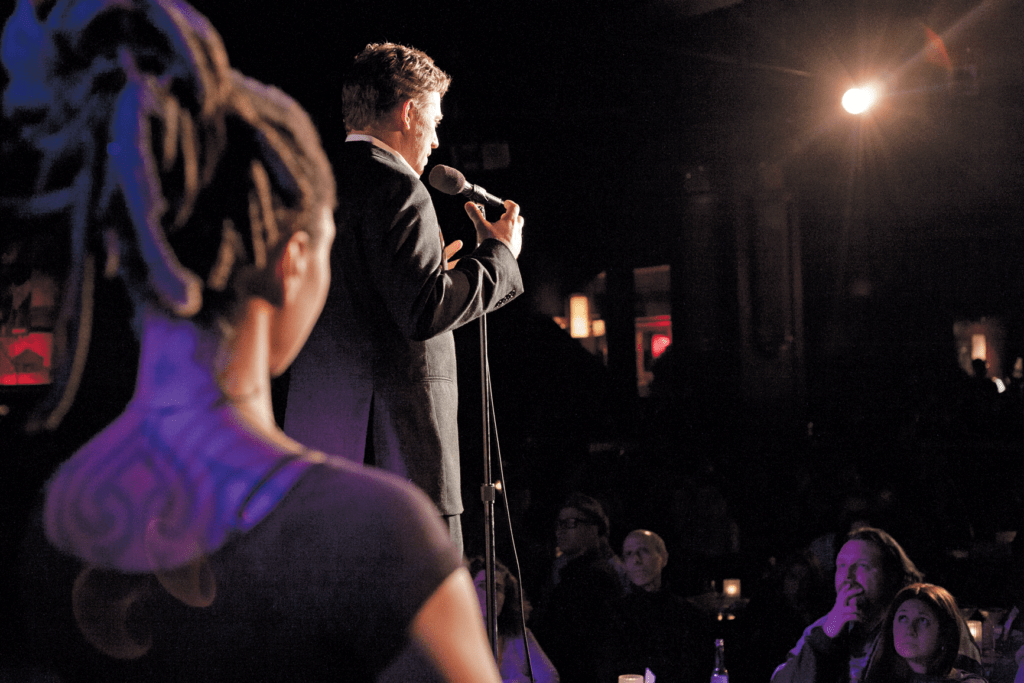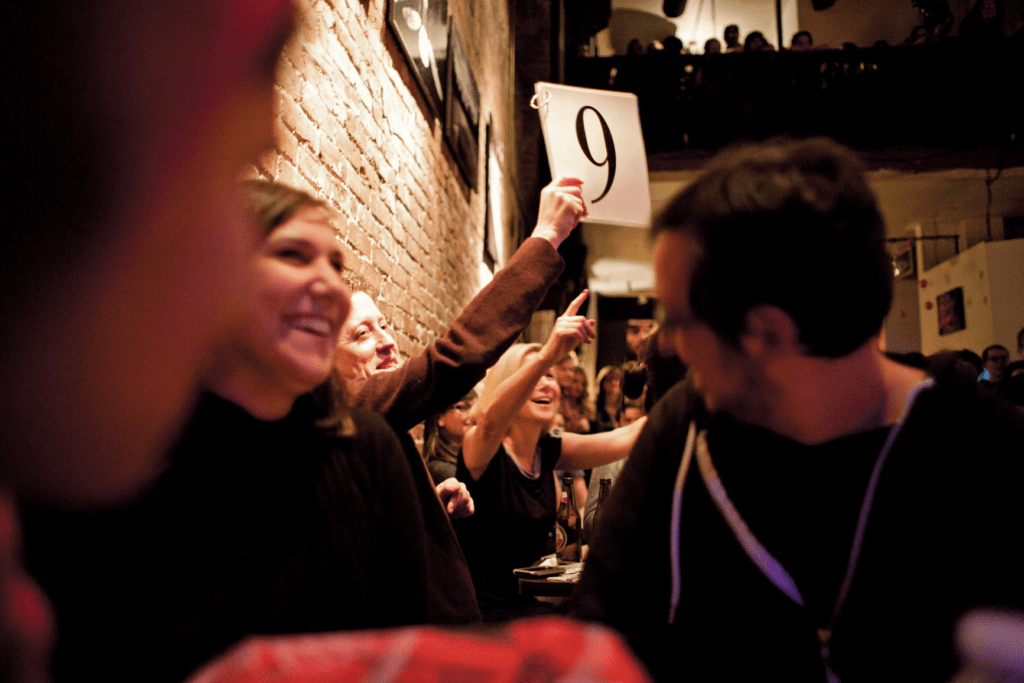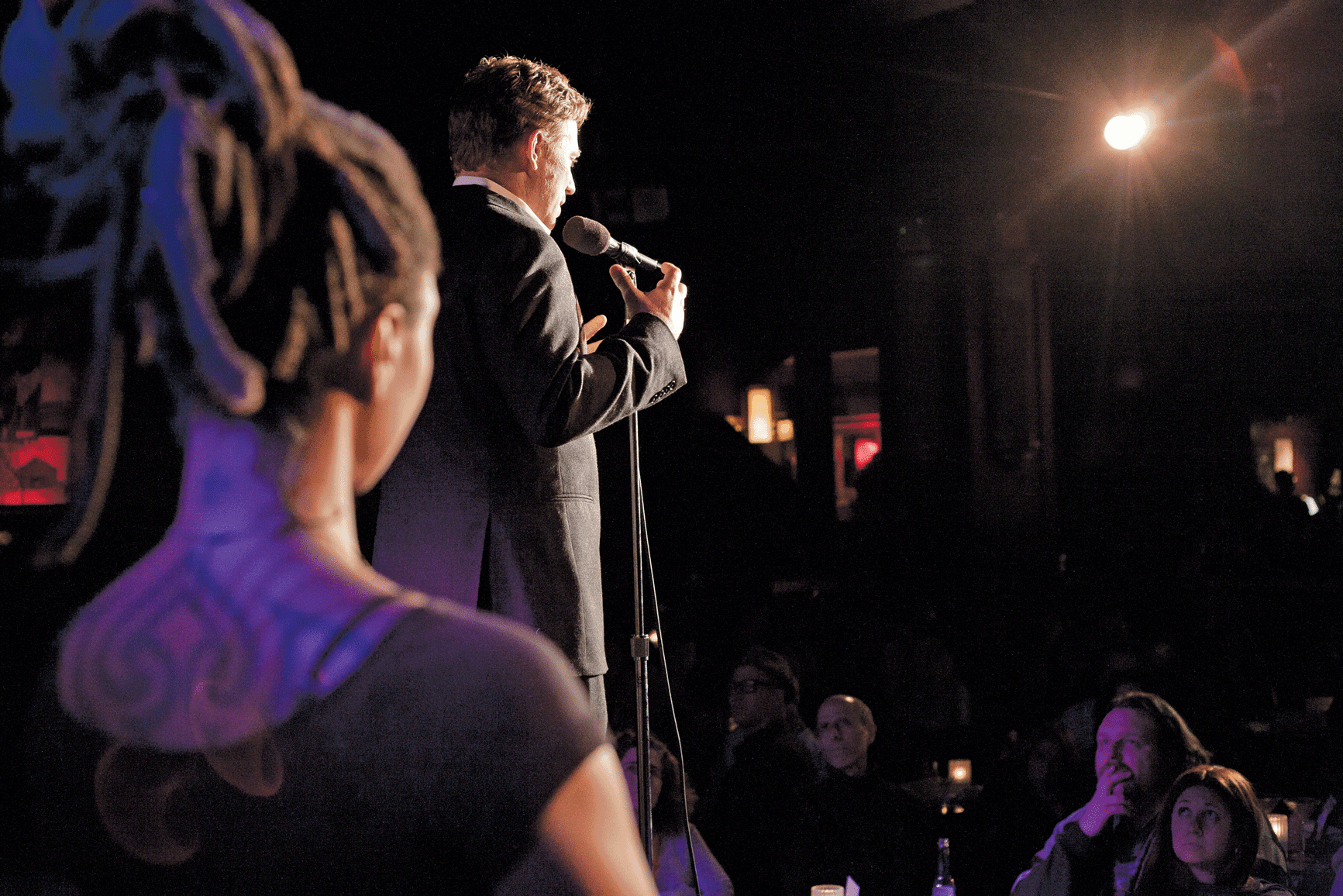
At a Moth StorySLAM at the Bell House in Gowanus, the most remarkable thing is that the live event is exactly as good as The Moth Radio Hour on WNYC. This is surprising because The Moth – a nonprofit whose mission “to promote the art and craft of storytelling and to honor and celebrate the diversity and commonality of human experience” has, since its 1997 inception in New York City, produced a nationwide empire that includes a podcast with 500,000 weekly listeners and two bestselling books – definitely has a hierarchy.
At the bottom, high school students participate in free Moth workshops, which not only help kids with their writing skills but, more crucially, allow an organization with $7 million in annual revenue to beg for listener donations at the start of every episode of its ad-heavy podcast. For The Moth’s public-facing live events – whose simple premise asks that people stand up and tell stories about themselves – there are three tiers.
The lowest is the StorySLAM, which is an open mic, except, unlike a traditional open mic, it charges a $10 entry fee, even if you’re a performer. Due to time constraints, perhaps two-thirds of those who show up looking for stage time will end up paying their money without getting a turn at the microphone. The host delegates judging to a few random audience members, who score ten stories (of five minutes each) from the lives of the crowd’s luckier volunteers.
The Bell House’s winner, with the highest average score, moves on to the Moth GrandSLAM at the Williamsburg Hall of Music to compete against other local winners. From here, they have a shot at the ultimate glory: the Moth Mainstage at Cooper Union’s Great Hall or, even better, The Moth Radio Hour, which appears on 400 public radio stations and on iTunes. Theoretically, storytellers at the Mainstage and on the Radio Hour, whose true stories double in length those of the StorySLAMs, could come from anywhere, but for an organization whose self-presentation is populist, many of the performers at The Moth’s highest levels emerge from a curiously elite circle.
While some may be nurses or ex-convicts who’ve worked their way up the ladder from a StorySLAM, others presumably receive direct invitations from George Dawes Green, the literary man-about-town who founded the organization in the hope of replicating the bourbon-scented front porch of his youth on St. Simons Island, Georgia, where, before moving to the big city, he’d sat and listened to his friends’ and neighbors’ stories all night long.
The upper echelon of The Moth represents someone’s idea of New York’s greatest dinner party. A renowned animal conservationist tells how he salvaged the dwindling jaguar population of Belize. An astronaut describes the terror and wonder of outer space. A physician explains how he rescued Mother Teresa from certain death by septic shock. Professional raconteurs and beloved New Yorker contributors recycle the well-worn anecdotes and themes that have saved them from performing an honest day’s work in decades: A.E. Hotchner on his wild days with Hemingway, Adam Gopnik on fatherhood, Jamaica Kincaid on her complicated relationship with her mother.
Every third person has a memoir to promote. For diversity, an NYPD cop, a Las Vegas card shark, a nun, and a Midwestern homemaker round out the table. The popular appeal of this well-mannered motley crew led the Wall Street Journal to label The Moth “New York’s hottest and hippest literary ticket,” which is kind of perfect: imagine the sort of thing that our preeminent fascist newspaper would think is hip, and you have The Moth.
A story for The Moth may be recorded in Phoenix or Milwaukee, but somehow it still sounds like it’s being told inside a townhouse in Park Slope – where, for example, a woman may give birth to twins on the very same day (!) that her very important novel is published, with a national tour expected of her. Every tale bears the same dependable structure, hitting all the right beats: a catchy hook that subsequently backs up to a personal introduction with an amiable dose of self-deprecation, an economical build-up of tension, a predictable but satisfying climax, an earnest moment of revelation, and maybe a cute tacked-on punchline after the resolution to cue applause.
It may employ spectacular coincidences that would be considered hackneyed in fiction: an inspiring old woman, just before her death, persuades a goodhearted but aimless young man working in a hospital geriatric unit to go back to school for occupational therapy, where he winds up learning anatomy by studying the brain of that very same woman. Every deep thought or final reflection must be painfully obvious, as when a woman attempts to deal with her parents’ hoarding problem: “I’ve come to realize that your physical space is a reflection of your mental, spiritual, and emotional state, and no matter how much I tried to clean in that house, it was always going to come back,” she observes in the end.

A Moth story is not especially sexual or violent. It may contain a great deal of pain, but it doesn’t lead the listener to any truly disagreeable conclusions about human life. The teller has some problems, but he is never a bad person. He has a sense of irony but doesn’t overuse it. He has recognizable and explicable emotions. Whether he’s discussing his wedding or the death of his sister, you understand where he’s coming from. He will never confuse you. He will always conjure a world that contains more good than bad: surprise and delight and humor in addition, perhaps, to tragedy. He may have an inclination toward whimsy or even a belief in the supernatural, but his story takes place firmly in reality, which is to say that it takes place within the ideological construct that the American bourgeoisie believes to be reality.
The Moth fits in perfectly between the wide-ranging human interest stories of This American Life and Terry Gross’s up-close-and-personal interviews with novelists and filmmakers on Fresh Air, where every work of art is revealed to be less important than its real-life backstory. It’s part of the essential media diet of educated people who still have their curiosity but have fully lost their imaginations.
At The Moth, stories are always personal; they’re never political. When the journalist Sebastian Junger remembers Sarajevo in 1993, he remembers not the conflict’s causes or effects but how its sights and sounds made him feel. Bill Clinton’s press secretary recalls the whirlwind nature of the job, not the political agenda he served. For him, the two are utterly separate. The Moth believes that the deepest, most important part of the human heart rests outside of history, beyond the reach of the state, because for the people who participate in The Moth, it always has.
Even so, The Moth has implicit politics: it’s liberal, which means that it’s capable of celebrating social progress as long it’s already happened and of lamenting social backwardness as long as the New York consensus has already deemed it backward. A heroic early female recruit at a U.S. military academy in the 1970s faces discrimination because her peers “didn’t get why I wanted to be a soldier and hunt down communists instead of hunting down a husband.” (The listener isn’t expected to evaluate whether hunting down communists was itself a worthy goal.)
A Pakistani Muslim in rural Missouri makes unexpectedly great friends in his new home but also sees his mosque burned down by bigots: “I knew that we could not rebuild this mosque, because no matter how much it meant to our community, no matter how much good it did, it was worth nobody’s life – certainly not my family’s. And with that in mind, I pledged to make sure no one would rebuild this mosque,” he narrates. For the audience of The Moth, this conclusion is self-evident: of course, no larger cause or principle could ever be worth dying for. In the world of The Moth, Barack Obama is still the president, and most problems will be solved through TED Talks.
Why does anyone pay to listen to narcissistic anecdotes in a theater when it’s bad enough to have to listen to them for free at parties? Fans of The Moth moved to Brooklyn, or to some similar place, under the assurance that they’d meet fascinating, eccentric, accomplished people and share witty evenings with them in bohemian settings.
Instead they work 60 hours a week in a soul-sucking office to afford rent for their shoebox, attend dispiriting social engagements alongside similarly drained denizens of the white-collar world, and listen to The Moth, which must know its base because its number-one sponsor appears to be LinkedIn Learning, a tool to help cubicle drones climb the corporate ladder. On The Moth’s podcast, LinkedIn Learning chimes in with complimentary, extremely depressing tips: for example, if you have a terrible boss, try praising him! That might put him in a better mood.
The Bell House, a bar and event space at 149 7th St., holds a Moth StorySLAM about once a month. Its participants are not vetted or coached. Anyone with $10 can put his name in the hat. Without any real barriers to entry, you might guess that a few oddballs would slip in: people who don’t fit the profile of The Moth, who don’t understand what it’s all about. But at November’s event, at least, this was not the case at all.
There were stories of lost virginity, online dating, stage fright, death in the family, college life, and children’s theater. Two sensitive, doting Brooklyn dads separately recounted the experience of witnessing childbirth. A motivational speaker explained how he learned to help entrepreneurs find the confidence to pursue their bold, uncompromising dreams.

The eventual winner, a gay man who had written a sex-and-drugs memoir of his youth, described his trepidation at sharing the private details of his life, in print, with his rural Texan father – who ended up loving his son all the more once he’d read the book. Each polished story was impeccably rehearsed, performed without notes or hesitation, usually in the same smartly casual diction used by the literati of The Moth Radio Hour. It was an amazing display, without any of the flakiness associated with open mics.
Of course, that was the problem. The Moth offers a crowd-pleasing formula that, on its smaller stages, empowers ordinary people to share their experiences in public for the first time, but in the process these experiences are forfeited to commodification, and the supplier isn’t even compensated. Turning our own autobiographies into digestible products that buttress an existing concept of reality and withhold their natural challenges to dominant overarching narratives can be as soothing as it is to consume such products. But this surrender of creativity condemns us to live in the world we inhabit today.
Only the restless, combative imagination can extricate the baffling and spectacular moments of our lives from the sterilizing structures that seek to claim them, and reinterpret their implications. In both fiction and nonfiction, real art isn’t meant to be so palatable. It may not meet The Moth’s standard of good storytelling. We must be willing sometimes to tell bad stories instead.










10 Comments
Fortunately, there are alternatives to the Moth – storytelling groups grounded in a single city – and some of us are even using storytelling to explore issues of power and equity. For example, I work for Ex Fabula in Milwaukee (a Google search for Milwaukee / storytelling alerted me of this article), and over the past 10 years, we’ve done bilingual (English Spanish) programming, explored ability and access, and even leveraged personal stories about race and equity to inspire community conversation and action.
Megan is onto something. Maybe the author is ignoring that alternate shows have addressed every criticism he has for The Moth. Or perhaps he didn’t get around to investigating whether there are storytelling shows that ARE “especially sexual or violent,” that do “lead the listener to truly disagreeable conclusions about human life,” that do allow people who have committed terrible crimes to speak, that do tackle “hard to recognize and inexplicable emotions,” that are often anything BUT “soothing” or “digestible,” and so on.
I’m the creator of RISK!, a show that takes excruciating amounts of psychic energy to produce. Why is it so exhausting to create? Just one of the reasons that putting a show into the world that includes points of view and topics that listeners might find challenging to hear is so hard is this: journalists ignore it. We get 1 million downloads a month. But what we don’t get are articles like this one. After 10 years of of this work, I’ve learned that if there’s an article that someone is going to write about storytelling, there’s a 99.9% that it is going to be about The Moth and The Moth only. The latest journalist, with their finger on the pulse of the culture, is not going to bother with a show that can be challenging to listen to. The latest journalist is going to check Google to see what the last 5000 journalists have written about and go with that. That will be The Moth, forever and ever, amen. But any publicity is good publicity, and thus… another brick in the wall.
If the author would like to listen to the RISK! episodes that include “Slave” by Mollena Williams, “Spitting in the Face of the Devil” by Bob Brader, “The Monster and the Man” by Larry Talbot, “The First Times” by D.K. Anderson, “Surrender” by Marcy Langlois, “In the Shadows” by Moloch Masters, “Another Saturday Night” by TS Madison, or “Unbreakable” by Melanie Hamlett, I seriously doubt he would conclude that storytelling in America today is all about remaining comfortably numb.
@ Kevin Allison
I am not shocked that you used the comments section of this article to promote your own show. Since you are here, though, why not share your thoughts on compensating storytellers? I mean, it is well-known in the community that you are happy to profit from the material and live performances without paying the contributors.
Want REAL STORIES? Come to The Dump!
Tuesdays 8pm at The Creek & the Cave in LIC Queens. Bad people, a bucket & 6 minutes to tell Any True Story. Free as shit & everyone gets up! Hosted by Jake Hart(RISK!, Nights Of Our Lives)
A rehearsed story is a performance, a story only in the intellectual sense it has a beginning, middle, and end. Curated performances or “stories” lack the emotional appeal and connection we make through personal narrative. Real stories have real emotions, real feelings. A performance may spring into existence from a more humble beginning of a true story, but here it’s stated perferctly. It becomes commodified. It’s easy to separate the hack standups using popular storytelling outlets as a free stage from the average person whose willing to share a private, personal experience. One is background noise with no ability to attract attention, the other keeps the listener capitavated, prioritized to the story above other input. Those are the stories where we work out a bit longer, stay in our car a few extra minutes, shed tears, laugh out loud, emote, react.
No one seems to be able to do that because it doesn’t sell. Human connection doesn’t sell. Mass quantities, that’s all that sells in America. Even in art. Sad, really.
@ Amateur Storyteller
Baloney. Romanticizing *not* rehearsing buys into the pernicious notion that “real” art is some kind of magical thing that happens instead of the product of rolling-up-your-sleeves, hard, painstaking work, which artists of all kinds (in this country, at least) have to do for little or no pay, for exactly the reason that comments like yours exemplify: People don’t believe that those moments of magic you describe and say you crave are the result of hard-earned, long-honed skill.
Whether or not you respond to a particular style of performance—and there are a lot of them—is entirely separate from whether it takes long hours of writing and rehearsal to create a moment onstage or in the studio that captivates an audience. You may think your comment is supporting “real” art, but it’s not. This kind of thinking is what makes it so easy for society as a whole to disrespect art, justify not paying artists, cut arts education programs, etc. I mean… why should society pay some people who are just lucky enough to have had some magic fairy-dust sprinkled on them, when everybody else is out there doing real work?
So…well played. You just made it harder for everyone.
@ Kevin Allison
I guess I am not shocked that you used the comments section of this article to promote your show. Since you are here, though, why not share your thoughts on compensating storytellers? I mean, it is well-known in the community that are happy to profit from the material and live performances without paying the contributors.
@ Risk-y Business
You should check your sources. I performed on RISK! live as recently as last summer and I was definitely compensated, as were all of the other storytellers on the lineup.
@susan kent
Thanks for the advice, but I have! Thoroughly! I know at least three performers who did road shows in different cities and received nothing. One was this past summer. Your show was here in NYC, right? How much did you receive as one of only four features, if you don’t mind me asking? $25? $50? Also, please let me know how much storytellers featured on the podcast are being paid for their contributions.
Hi @Risk-y Business. Do you know that from appearing on RISK! in the past, or are you basing your comment on a rumor? I’ve been a performer on RISK! live as recently as last summer, and I was definitely compensated, as were the other storytellers on the lineup.